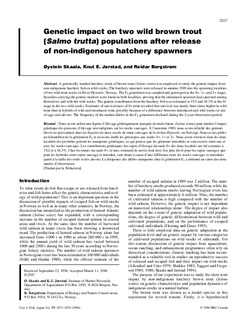| dc.description.abstract | A genetically marked hatchery strain of brown trout (Salmo trutta) was employed to study the genetic impact from
non-indigenous hatchery fish on wild stocks. The hatchery spawners were released in autumn 1989 into the spawning localities
of two wild trout stocks in River Øyreselv, Norway. The F1 generation was sampled and genotyped at the 0+, 1+, and 2+ stages.
Juveniles carrying the genetic markers were found in both localities, proving that the introduced spawners had spawned among
themselves and with the wild stocks. The genetic contribution from the hatchery fish was estimated at 19.2 and 16.3% at the 0+
stage in the two wild stocks. Estimates of survival rates of 0+ trout revealed that survival was nearly three times higher in wild
trout than in hybrids of wild and introduced trout, possibly because of a difference between introduced and wild stocks in size
of eggs and alevins. The frequency of the marker alleles in the F1 generation declined during the 2-year observation period. | en |
